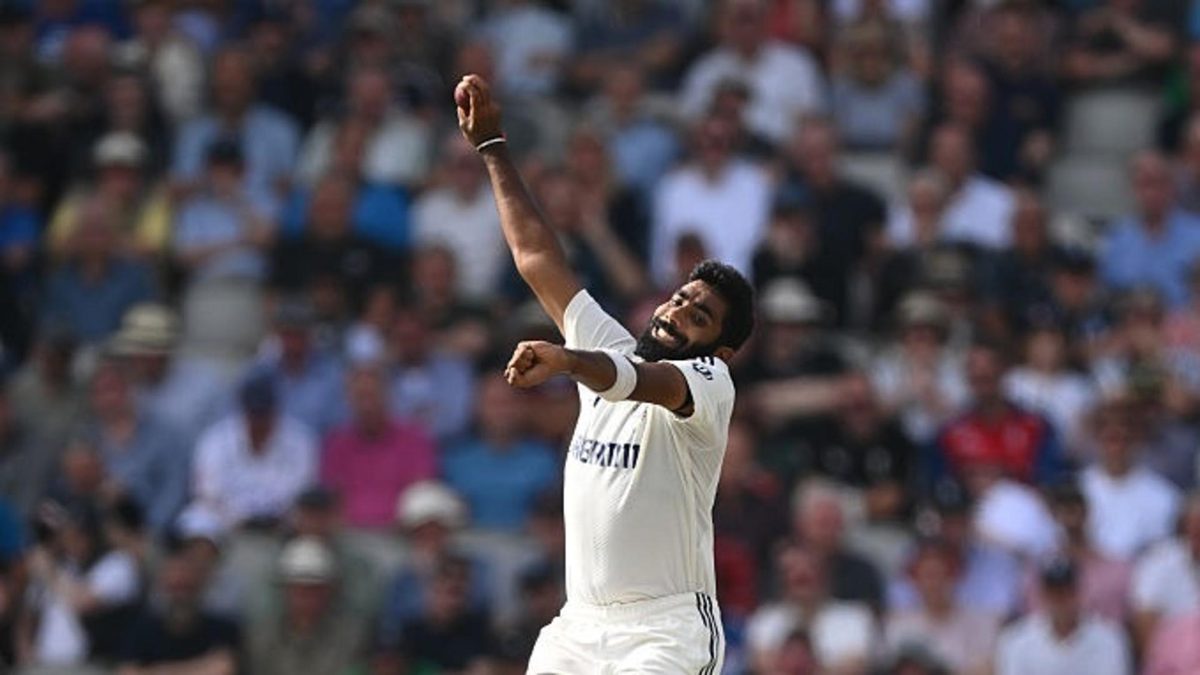
Should India be worried about Jasprit Bumrah's new-ball returns? Naman Agarwal digs into the numbers.
When Jasprit Bumrah squared Zak Crawley up with his sixth ball of the series at Headingley, it felt like the world had clicked into place. The best bowler of his generation was making batters look foolish within minutes of having the brand new cherry in his hand. Inswing. Outswing. Balls rearing up off a length, whizzing past the bat, some catching the edge. Bumrah put on the sort of exhibition that only he is blessed with the ability to.
His first five-over burst saw him take 1-21. In his second, he lured a well-set Ben Duckett into an expansive drive, only for the left-hander to drag the ball onto his stumps.
But that opening spell may have been the exception, not the rule.
Since then, Bumrah has taken 10 more wickets in the series by the end of day two in Manchester, but none with the (first) new – or even newish – ball. The numbers suggest something awkward: India’s best bowler might not be at his best upfront.
Including the two first-innings wickets at Headingley, Bumrah’s average in his first two spells across the series reads an astonishing 82.5, with a wicket coming only every 165 balls.
At Old Trafford, Shubman Gill and India came under the scanner for handing the new ball to debutant Anshul Kamboj ahead of the experienced Mohammed Siraj. But while Kamboj was a scattergun in his first spell, struggling to find any consistency with line or length, Bumrah himself looked surprisingly out of rhythm in what was the most helpful period in the series for bowlers in terms of movement on offer, according to CricViz data.
Duckett and Crawley capitalised on the loose offerings, racing off to 77-0 in 14 overs before tea, eventually stitching a 166-run opening stand and putting England firmly in the driver’s seat.
There’s no doubt Bumrah has still been by far India’s best bowler in the series, with 12 wickets at 24.08, but his inability to produce early breakthroughs with the new ball has posed two problems: England’s middle order hasn’t been exposed early on enough occasions, and India’s other more new-ball-dependent seamers have had to come in first- and second-change to bowl at well-set batters.
England have lost their first two wickets inside 30 runs only twice in seven innings, both in the Edgbaston Test where Bumrah didn’t play. On three of the seven occasions, their second wicket has fallen after 125 runs. Yes, India’s Bumrah and non-Bumrah bowling averages and economy rates in this series have had a stark contrast – 24 vs 42 and 2.89 vs 4.13 – and they have often collectively looked flat as a bowling unit beyond their main man, but Bumrah himself hasn’t quite met the ridiculous standards he sets.
In the Australia series preceding the England tour, Bumrah had elevated to a different level, taking 32 wickets at 13.1 apiece. He had been equally, if not even more lethal with the new ball, averaging 10.6 in the first 20 overs of the innings compared to 15 after. However, in the Anderson-Tendulkar Trophy, that new ball average has shot up to 99.
Duckett has looked especially at ease against Bumrah, rarely misreading the direction of swing and looking to score at every half-opportunity presented. Crawley has found it tougher going, often getting hit on the handle and gloves, but has managed to survive through it all after playing through the wrong line in Headingley. Even Ollie Pope, for all his technical frailties, has been largely untroubled by Bumrah.
This isn’t the first time Bumrah has seemed to struggle with the new ball. In his first tour to the UK in 2018, he took only four wickets in the first 20 overs at 29.2. In fact, across South Africa, New Zealand, England, and India, Bumrah’s average in the first 20 overs of an innings balloons to 32.7, a stark contrast to his career average of 19.65.
Bumrah's effectiveness before and after 20 overs across countries in Test cricket
| First 20 overs | After 20 overs | |||||
| Host nation | Wickets | Avg | SR | Wickets | Avg | SR |
| Australia | 20 | 17.8 | 43.8 | 44 | 16.9 | 38.2 |
| England | 13 | 30 | 66.4 | 36 | 24.2 | 52.1 |
| India | 10 | 33.3 | 67.8 | 37 | 12.8 | 26.9 |
| New Zealand | 0 | - | - | 6 | 20.7 | 39 |
| South Africa | 8 | 31.6 | 71.9 | 30 | 17.9 | 33.9 |
| West Indies | 10 | 5 | 17.5 | 3 | 23.3 | 40 |
It’s almost blasphemous to even conjure a thought like this, but the perfect fast bowler might not be as good with the new ball as he is with the old – an anomaly that would be very much on-brand with the unorthodoxy that defines Bumrah.
Also read: India's misuse of new-ball dependent Shardul Thakur is a blunder of selection and tactics
While it can be argued that the weaker suit of Bumrah’s bowling would still be stronger than the strengths of most other bowlers, the make-up of India’s seam attack presents a solid case for them to consider using Bumrah first-change. Siraj averages 30 when opening the bowling compared to 33.5 when not. Shardul Thakur and Kamboj are predominantly swing bowlers. Akash Deep showed what he can do with the moving new ball at Edgbaston.
Also read: Why is Mohammed Siraj so much better without Jasprit Bumrah in India's Test XI?
The prospect of having to face Bumrah after negotiating the opening spell would add a different dynamic to batters’ gameplans as well, potentially opening up more wicket-taking opportunities for the new-ball bowlers, who would already be bowling in a more optimal phase based on their strengths. Bumrah would also be better equipped to deal with set batters if the opening bowlers fail to make inroads.
As radical as the move sounds, Bumrah and India don’t need to look too far in search of inspiration. One of his greatest contemporaries, Pat Cummins, has nailed the first-change role, picking up 116 wickets at 24.36. Closer home – as of now, at least – there is Morne Morkel, India’s current bowling coach, who was one of the greatest first-change bowlers in the history of the game, having picked up 129 wickets, the joint-highest tally for a No.3 bowler alongside Ian Botham.
Fast bowlers with most wickets bowling first-change in Test cricket
| Player | Inns | Wkts | Ave | Econ | SR | 5-fors | 10-fors |
| Ian Botham (ENG) | 53 | 129 | 25.12 | 2.96 | 50.9 | 10 | 2 |
| Morne Morkel (SA) | 73 | 129 | 30 | 3.12 | 57.5 | 2 | 0 |
| Pat Cummins (AUS) | 54 | 116 | 24.36 | 2.88 | 50.6 | 5 | 2 |
| Courtney Walsh (WI) | 60 | 106 | 26.16 | 2.65 | 59.1 | 3 | 1 |
| Andrew Flintoff (ENG) | 50 | 94 | 29.11 | 2.95 | 59.1 | 2 | 0 |
It is worth a mention that apart from Cummins, the others went through significant phases where when they were not among the two best bowlers of the XI.
Of course, removing Bumrah from new-ball duties risks overcomplicating the proven formula of giving the new ball to the best bowler in the team and potentially denting his rhythm. But this is more about how to maximise the collective output of the bowling attack than doubting Bumrah’s excellence.
Maybe it’s time India stop leading with their trump card and start holding him back for the right moment.








